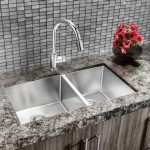When it comes to cleaning and sanitation in the kitchen, sink protection is critical. By using a kitchen sink protector, you can keep your sink clean and sanitary without having to constantly scrub and sanitize it. Here are some tips on how to choose the right sink protector and properly use it.
Types of Kitchen Sink Protectors
There are several types of kitchen sink protectors available, ranging from basic mats to more advanced designs. Basic mats are typically made of rubber or vinyl and can be easily cleaned with a damp cloth. They are ideal for basic protection and can prevent scratches and minor damage to the sink.
More advanced designs include sink grids, which are designed to fit the size of your sink and provide extra protection from scratches and dents. They also provide a designated spot for dishes and utensils, making it easier to clean up after meals. Other advanced designs include sink liners, which are designed to fit the exact shape and size of your sink and provide an extra layer of protection against scratches and dents.
Choosing the Right Kitchen Sink Protector
When choosing a kitchen sink protector, it’s important to consider the size, shape, and type of sink you have. If you have a large sink, you’ll want to choose a larger mat or grid to protect the entire area. For smaller sinks, you may want to opt for a more specialized design that fits the exact shape of your sink.
It’s also important to consider the material of your sink protector. Rubber and vinyl are both popular materials, but rubber may be better suited for areas with heavy usage, while vinyl may be better for areas with lighter usage. Additionally, some sink protectors are designed to be resistant to heat, making them a good choice for sinks that come into contact with hot water.
Properly Using Your Kitchen Sink Protector
Once you’ve chosen the right kitchen sink protector for your needs, it’s important to properly use it. Make sure to clean the protector regularly with a damp cloth to remove any dirt or debris that could lead to bacteria growth. Additionally, avoid leaving dishes and utensils on the protector for extended periods of time as this can cause scratches or other damage.
Finally, it’s important to inspect your sink protector regularly for signs of wear and tear. If you notice any cracks, tears, or other damage, replace the protector immediately to ensure your sink remains clean and sanitary.















Related Posts








